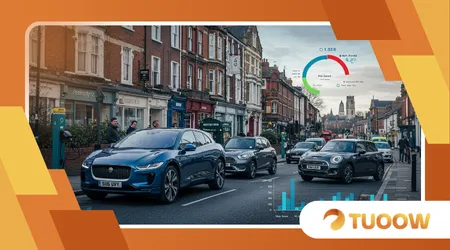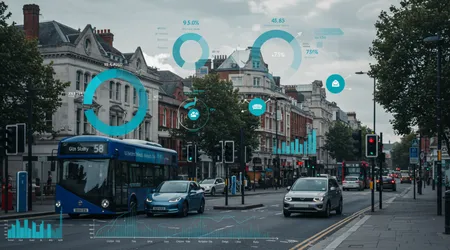UK Electric Vehicle Adoption: Latest Growth Statistics

The data confirms that UK Electric Vehicle Adoption has moved past the niche early-adopter phase and is now fundamentally restructuring the nation’s transport sector.
As of 2025, the pace of change presents both remarkable opportunities and significant challenges for infrastructure and policy makers.
This deep-dive analysis leverages the latest statistics to assess the true momentum of the electric revolution and dissect the crucial drivers and constraints shaping its trajectory.
We must look beyond simple registration numbers to understand the market’s dynamics. The story is one of dual-speed growth: aggressive expansion in commercial fleets contrasting with more hesitant private consumer demand.
Understanding this split is key to forecasting how the UK Electric Vehicle Adoption trend will evolve throughout the rest of the year and into 2026.
The Fleet-Footed Frontrunners: Business vs. Private Demand
The most compelling insight into UK Electric Vehicle Adoption comes from distinguishing between buyers. Business and fleet registrations are overwhelmingly driving the volume, while private sales demonstrate a more cautious approach.
Fleet Sales Accelerate Market Penetration
Fleet and business registrations remain the undisputed engine of the UK’s EV transition. Companies benefit hugely from favorable tax incentives, notably the low Benefit-in-Kind (BiK) tax rates for zero-emission vehicles.
These financial advantages make the Total Cost of Ownership (TCO) for an electric vehicle highly compelling for corporate buyers, leading to a massive volume of bulk orders.
According to the Society of Motor Manufacturers and Traders (SMMT), data for January through July 2025 shows battery electric vehicle (BEV) registrations grew by a substantial 31.0% year-on-year.
This growth is predominantly fueled by fleet demand as companies rush to electrify their car parks and meet their own sustainability goals. These sales provide crucial volume, increasing the overall share of EVs on UK roads dramatically.
This business-led surge creates a positive secondary market effect. As fleet vehicles reach the end of their lease cycles, they enter the used car market, increasing the supply of more affordable used EVs. This inevitable flow will eventually stimulate the private sector, but it hasn’t fully compensated for current retail hesitancy.
Private Buyer Hesitancy and the Affordability Barrier
Despite the overall positive trend, private demand for BEVs has struggled to keep pace with fleet growth. Private buyer registrations saw a decline in parts of 2024, continuing a concerning trend. Private buyers lack the substantial tax breaks enjoyed by corporate fleets.
The primary barriers are two-fold: affordability and charging confidence. Though the average price of popular used BEVs and hybrids has dropped (by almost 13% in Q2 2025 compared to Q2 2024), the upfront cost of a new electric car often remains too high for many households.
The government’s recent reintroduction of upfront purchase incentives (up to £3,750 for qualifying ZEV models in August 2025) aims to address this critical affordability gap.
It’s clear that sustained, broad-based UK Electric Vehicle Adoption requires the government to alleviate these financial pressures on the average household.
A major policy decision, such as halving VAT on new EV purchases, remains a key industry ask to unlock private consumer demand.

Infrastructure: The Race to Power the Future
The growth in the electric vehicle population is meaningless without the charging infrastructure to support it. The public charging network’s expansion is a direct determinant of consumer confidence.
Also read: UK Unemployment Rate 2025: What the Numbers Reveal
The Ultra-Rapid Revolution
Recent statistics confirm a significant improvement in the speed of public charging, a crucial factor for long-distance drivers. The network has seen aggressive growth in high-power charging, which directly tackles ‘range anxiety’.
Zapmap data indicates that the total number of public charge points in the UK has experienced high growth, with over 73,000 devices recorded by early 2025. Crucially, the ultra-rapid segment (150kW and above) saw the most significant surge, with an 83% increase in installations in 2024.
The total number of high-power charging hubs (featuring six or more rapid devices) more than doubled in that year.
This installation focus on speed is vital. It creates an “analogy of convenience” for drivers: just as filling a petrol tank takes minutes, charging an EV for a critical top-up now offers a similar level of time efficiency at key motorway and retail hubs. This focus on driver experience is essential for sustained UK Electric Vehicle Adoption.
Read more: London vs Manchester: Comparing Housing Affordability in 2025
Regional Disparity and the On-Street Gap
While the national figures are encouraging, regional disparities persist, creating a two-tier system of adoption. Greater London and Scotland consistently lead the nation in charger provision per capita. Conversely, areas like Northern Ireland and the North West lag significantly behind.
More importantly, on-street charging vital for the approximately 40% of UK households without a driveway remains concentrated.
Although on-street devices are increasing, the geographical imbalance discourages prospective EV owners in dense urban areas without guaranteed off-street parking. This lack of equitable access is a substantial brake on overall UK Electric Vehicle Adoption.
The recent Public Charge Point Regulations (PCPR), introduced in late 2024, are a welcome policy intervention.
These regulations mandate 99% reliability for new rapid chargers and enforce contactless payment, directly addressing the key consumer frustrations of broken chargers and inconvenient payment methods. Better reliability means better charging confidence.
Policy and Mandates: The Regulatory Whiplash
The UK government’s commitment to the Zero Emission Vehicle (ZEV) Mandate is the most powerful regulatory tool accelerating UK Electric Vehicle Adoption. However, its ambitious targets are forcing manufacturers into strategic moves that benefit buyers but highlight market deficits.
The ZEV Mandate vs. Reality
The ZEV Mandate requires 28% of new car sales in 2025 to be zero-emission vehicles (ZEVs). SMMT data for July 2025 showed that BEV registrations achieved a 21.3% market share year-to-date, still falling short of the mandated 28% target.
This shortfall has resulted in manufacturers aggressively pushing incentives and offering deep discounts to meet compliance targets, especially during quarter-end sales surges.
While this is great for consumers seeking a bargain, it suggests the market isn’t yet naturally meeting the required trajectory without significant industry subsidy. This “artificial boost” needs structural support to become sustainable.
The industry is navigating the mandate through strategic compliance mechanisms, such as using CO2 credits earned from improving non-zero-emission vehicles.
This flexibility effectively lowered the required compliance target in 2024 (from 22% to an effective 18%), showing the policy’s real-world elasticity. Nonetheless, the mandate remains a potent supply-side driver that ensures a steady increase in the availability of new EV models.
The Market in Numbers: 2025 Trajectory
The latest SMMT registration figures highlight the stark contrasts in powertrain market share for the year-to-date (Jan-July 2025).
| Powertrain Type | Registrations (Jan-Jul 2025) | Market Share (Jan-Jul 2025) | YoY Growth vs. 2024 |
| Battery Electric (BEV) | 254,666 | 21.5% | +31.0% |
| Plug-in Hybrid (PHEV) | 124,528 | 10.5% | +31.5% |
| Full Hybrid (HEV) | 165,328 | 14.0% | +6.5% |
| Petrol/Diesel (Combined) | 637,851 | 53.9% | -10.1% / -10.9% |
Statistic Reference: SMMT, Year-to-Date (Jan-July) New Car Registration Data, 2025.
The table clearly illustrates the powerful momentum of plug-in vehicles (BEV and PHEV combined), which now account for 32.0% of all new car registrations.
Conversely, traditional petrol and diesel powertrains continue a relentless decline, losing over 10% in registration volume year-on-year. This rapid structural shift confirms the irreversible nature of UK Electric Vehicle Adoption.
Conclusion: Momentum and the Missing Piece
The latest statistics paint a clear picture: UK Electric Vehicle Adoption is undeniably moving at pace, primarily powered by aggressive fleet expansion and regulatory pressure.
We’ve seen significant progress in the speed and reliability of charging infrastructure. However, the market remains fragile, hampered by the persistent reluctance of the private buyer, who still views new EVs as an inaccessible premium purchase.
The government’s challenge lies in converting the high volume of corporate sales into sustained, organic retail demand by addressing affordability and improving on-street charging equity.
Until policies truly support the individual, and not just the corporation, the UK will continue to play catch-up with its own ambitious ZEV targets. Will policymakers take the necessary steps to make EVs truly accessible to the masses this year?
Share your opinion: What single government policy would most effectively unlock private EV ownership in the UK? Let us know in the comments.
Frequently Asked Questions (FAQ)
Q: Why are fleet sales so much stronger than private sales?
A: Fleet sales are stronger because of substantial tax incentives. The low or zero Benefit-in-Kind (BiK) tax for company EVs makes them financially superior to petrol/diesel cars for both the employer and employee. Private buyers do not benefit from this significant tax break, making the higher initial purchase price a major deterrent.
Q: How much more expensive is public charging than home charging in the UK?
A: Charging at a public rapid charger is significantly more expensive than charging at home, often costing at least three to four times more per kWh.
Home charging, especially when utilizing off-peak electricity tariffs, can cost as low as 9-10p per kWh, making it the most cost-effective method. The high cost of public charging remains a serious hurdle for those without private driveways.
Q: What is the ZEV Mandate and what is the 2025 target?
A: The Zero Emission Vehicle (ZEV) Mandate is a government regulation requiring manufacturers to sell an increasing percentage of ZEVs each year.
The target for 2025 is 28% of a manufacturer’s total new car sales to be zero-emission vehicles (primarily BEVs). This policy ensures supply, forcing the market to focus on electric models.
Q: How many public charge points are there currently in the UK?
A: As of early 2025, there are over 73,000 public electric vehicle charging devices installed across the UK. Crucially, the growth rate is increasing, with the highest growth seen in ultra-rapid (150kW+) devices.
